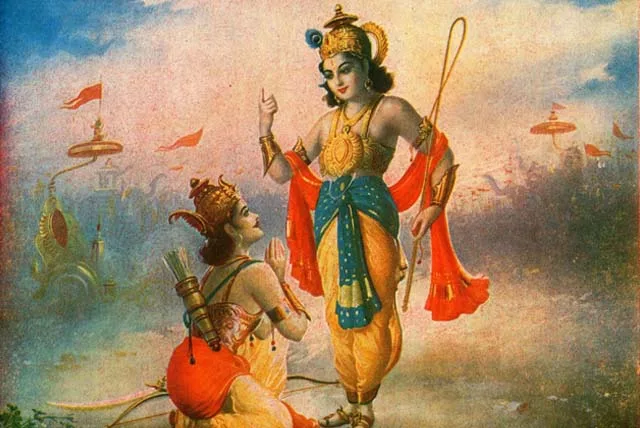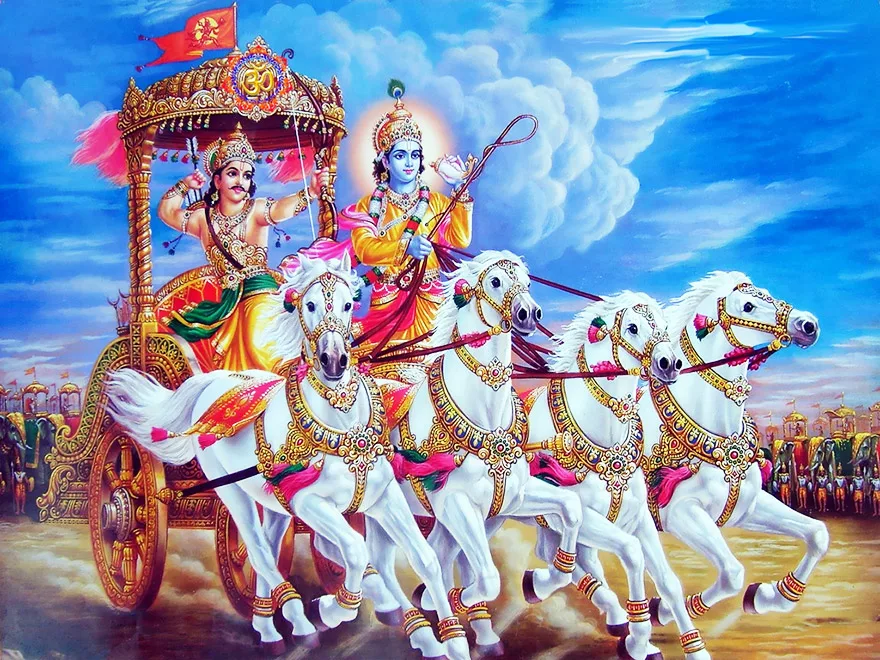The Bhagavad Gita
Discovering Wisdom: Exploring the Bhagavad Gita in 30 Key Insights
The Bhagavad Gita, a timeless and revered scripture, holds a special place in the hearts of spiritual seekers worldwide. Nestled in the rich tapestry of Indian philosophy, this ancient text offers profound insights into the human experience and the path to self-realization. Let’s embark on a journey of discovery as we explore the Bhagavad Gita through 30 key insights.

1- Origin of the Gita: The Bhagavad Gita is a 700-verse Hindu scripture that forms a vital part of the Indian epic, the Mahabharata. It is a dialogue between Prince Arjuna and Lord Krishna.
2- The Central Characters: Arjuna, the skilled warrior, represents the human struggle, while Lord Krishna embodies divine wisdom and guidance.
3- Arjuna’s Moral Dilemma: Arjuna’s inner conflict reflects the universal human struggle between duty and personal values, a dilemma that many of us encounter in life.
4- The Concept of Dharma: Dharma, in the Gita, is the righteous path or duty that each person must follow. It’s a guiding principle for making ethical decisions.
5- Paths to Spiritual Growth: The Gita introduces three paths to spiritual growth, catering to different temperaments: Karma Yoga, Bhakti Yoga, and Jnana Yoga.
6- Karma Yoga: Selfless Action: Karma Yoga emphasizes selfless action, teaching us to perform our duties without attachment to the outcomes.
7- Surrendering Outcomes: Krishna advises Arjuna to act without attachment to success or failure, emphasizing dedicating the results to a higher purpose.
8- The Eternal Soul (Atman): The Gita introduces the concept of the eternal soul (atman), distinct from the physical body, representing our true self.
9- The Battlefield Symbolism: The battlefield of Kurukshetra is a metaphor for the world we live in, where we face moral and ethical conflicts.
10- Yoga as Union: Yoga, often associated with physical postures, here signifies the union of the individual soul with the universal consciousness, representing spiritual oneness.
11- The Importance of Discipline: Discipline is fundamental to spiritual progress. It involves self-control, focused effort, and dedication to one’s chosen path.
12- Equanimity in Success and Failure: The Gita teaches us to maintain equanimity, treating success and failure alike. This balanced perspective is essential for inner peace.
13- Devotion to a Higher Power: Bhakti Yoga emphasizes devotion to a higher power, a path to spiritual growth through love and surrender.
14- Detachment from Material Possessions: Detachment from material possessions and outcomes reduces suffering and leads to spiritual liberation.
15- Arjuna’s Confusion: Arjuna’s initial confusion symbolizes the inner turmoil many experience when facing life’s challenges and dilemmas.
16- Different Paths for Different People: The Gita acknowledges that individuals have diverse temperaments and inclinations, offering various spiritual paths to suit everyone.
17- Meditation and Mind Control: Meditation is a means to control the mind, achieving a state of deep focus and inner peace, essential for spiritual growth.
18- Conquering Desires and Senses: Mastery over desires and senses is a path to self-realization, helping us transcend worldly distractions.
19- Sankhya Philosophy: Sankhya philosophy distinguishes between the physical body and the eternal soul, deepening our understanding of our existence.
20- Krishna’s Divine Form: Krishna reveals his cosmic, divine form to Arjuna, emphasizing his omnipresence and universal nature.
21- Inner Peace Amidst Challenges: The Gita teaches that inner peace is attainable even amidst life’s challenges through spiritual insight and practice.
22- The Three Gunas: The three gunas—sattva (goodness), rajas (passion), and tamas (ignorance)—influence human behavior and choices, leading to different paths in life.
23- Recognizing the Eternal Soul: Realizing the eternal nature of the soul leads to profound wisdom and spiritual growth.
24- Selfless Service and Compassion: Acts of selfless service and compassion are central to personal and collective well-being, fostering positive change in the world.
25- Faith and Surrender: Faith in a higher power and surrender to the divine will deepen one’s spiritual connection and growth.
26- Universal Teachings: The Bhagavad Gita’s teachings transcend religious boundaries, offering valuable insights into the human condition and spirituality.
27- Krishna’s Guidance: Krishna’s guidance encourages Arjuna to overcome his doubts and fulfill his responsibilities, teaching us to face our challenges with strength and determination.
28- Moksha: Liberation: The ultimate goal of human life, as taught by the Gita, is Moksha, liberation from the cycle of birth and death, achieving union with the divine.
29- Inspirational Impact: The Bhagavad Gita’s profound teachings have inspired philosophers, leaders, and spiritual seekers for centuries, leaving an indelible mark on humanity.
30- Timeless Wisdom: The timeless wisdom of the Bhagavad Gita continues to guide individuals on their journeys towards self-realization and inner peace, transcending the boundaries of time and culture.





